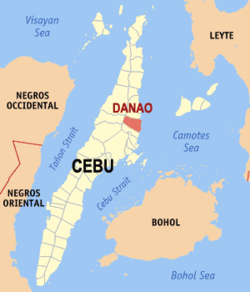Danao, Cebu
| Danao | ||
|---|---|---|
| Component City | ||

Aerial view of Danao
|
||
|
||
 Map of Cebu with Danao highlighted |
||
| Location within the Philippines | ||
| Coordinates: 10°31′N 124°02′E / 10.52°N 124.03°ECoordinates: 10°31′N 124°02′E / 10.52°N 124.03°E | ||
| Country | Philippines | |
| Region | Central Visayas (Region VII) | |
| Province | Cebu | |
| District | 5th district of Cebu | |
| Founded | 1570 (as ecomienda) 1609 (as a Recollect parish) 1773 (as municipality) |
|
| Cityhood | 7 June 1961 | |
| Barangay | 42 (see § Barangays) | |
| Government | ||
| • Type | Sangguniang Panlungsod | |
| • Mayor | Nito Durano (LP) | |
| • Vice mayor | Mix Durano | |
| • City Council |
Members
|
|
| • Representative | Red Durano | |
| Area | ||
| • Total | 107.30 km2 (41.43 sq mi) | |
| • Cadastral | 121.78 km2 (47.02 sq mi) | |
| Population (2015 census) | ||
| • Total | 136,471 | |
| • Density | 1,300/km2 (3,300/sq mi) | |
| • Voter (2016) | 86,085 | |
| Time zone | PHT (UTC+8) | |
| ZIP code | 6004 | |
| IDD : area code | +63 (0)32 | |
| Income class | 3rd class | |
| PSGC | 072223000 | |
| Website | www |
|
Danao is a 3rd city income class component city in the province of Cebu, Philippines. According to the 2015 census, it has a population of 136,471. In the 2016 electoral roll, it had 86,085 registered voters.
Danao lies within Metro Cebu area.
The area of what is now Danao used to be the Cebuano Kingdom of Nahalin before the conquest of Cebu by the Spanish starting in 1565. In 1570 it became an ecomienda or a farmland controlled by certain Spanish officials, only to be abolished in the 18th century as abuses to the native workers became apparent. In 1609 Danao was made a parish by the Recollects, and much later in 1773 it officially became a municipality.
Much physical changes occurred in Danao as it went and passed through the 20th century. Mining, cement making and gun making industries made the once sleepy town of Danao so prosperous that in 1961 a national charter was passed to convert it into a city.
Danao City comprises 42 barangays:
In the 2016 electoral roll, it had 86,085 registered voters, meaning that 63% of the population are aged 18 and over.
Danao City is well known for its gun industry. The industry started around 1905–1906. When World War II came, the Danao gunsmiths went underground, joined the guerrilla movement or were inducted into the USAFFE. Their main task was to re-chamber the Japanese Arisaka rifles to fit the US .30 caliber round or to keep the original Japanese rifle in good service.
The industry went on, still underground. In the 1960s, the term paltik was given to the homemade (and illegal) guns. In the early 1990s the industry was legalized by the government, with the creation of two organizations of local gunsmiths. The organization now left with proper permit is Workers League of Danao Multi-purpose Cooperative (World MPC), in Dungguan, Danao City.
Workers League of Danao Multi-Purpose Cooperative (World MPC) was incorporated on October 16, 1994 with twenty-five initial members. It was given license to manufacture handguns from caliber .22 to .45 by the Philippine National Police (PNP) on November 12, 1996. The organization has been a potent group in working for the legalization of gun making industry in the country with the aim to upgrade the technology and skills of gun makers, to provide job security and additional revenue for the government. The gun making industry in Danao was pioneered by Mario Durano using brass or copper as materials. Nestor V. Sabayton, the Chairman of World MPC for many years, was in charge for the compliance of the requirements of the Firearms Explosives Security Service Agency and Guards Supervisory Section (FESSAGES) until he was diagnosed for a lung cancer on April of 2010. The said cooperation was then shutdown in 2010 for non-compliance of FESSAGES policies.
...
Wikipedia


